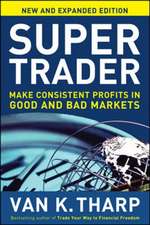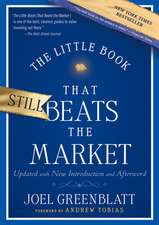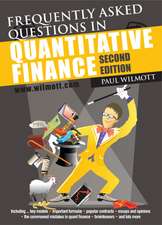Stochastic Dominance: Investment Decision Making under Uncertainty
Autor Haim Levyen Limba Engleză Paperback – 23 aug 2016
Stochastic Dominance: Investment Decision Making under Uncertainty, 3rd Ed. covers the following basic issues: the SD approach, asymptotic SD rules, the mean-variance (MV) approach, as well as the non-expected utility approach. The non-expected utility approach focuses on Regret Theory (RT) and mainly on prospect theory (PT) and its modified version, cumulative prospect theory (CPT) which assumes S-shape preferences. In addition to these issues the book suggests a new stochastic dominance rule called the Markowitz stochastic dominance (MSD) rule corresponding to all reverse-S-shape preferences. It also discusses the concept of the multivariate expected utility and analyzed in more detail the bivariate expected utility case.
From the reviews of the second edition:
"This book is an economics book about stochastic dominance. … is certainly a valuable reference for graduate students interested in decision making under uncertainty. It investigates and compares different approaches and presents many examples. Moreover, empirical studies and experimental results play an important role in this book, which
makes it interesting to read." (Nicole Bäuerle, Mathematical Reviews, Issue 2007 d)
| Toate formatele și edițiile | Preț | Express |
|---|---|---|
| Paperback (2) | 1009.85 lei 6-8 săpt. | |
| Springer International Publishing – 23 aug 2016 | 1009.85 lei 6-8 săpt. | |
| Springer Us – 25 noi 2010 | 1491.25 lei 6-8 săpt. | |
| Hardback (1) | 1016.18 lei 6-8 săpt. | |
| Springer International Publishing – 12 noi 2015 | 1016.18 lei 6-8 săpt. |
Preț: 1009.85 lei
Preț vechi: 1231.52 lei
-18% Nou
Puncte Express: 1515
Preț estimativ în valută:
193.24€ • 206.63$ • 161.12£
193.24€ • 206.63$ • 161.12£
Carte tipărită la comandă
Livrare economică 18 aprilie-02 mai
Preluare comenzi: 021 569.72.76
Specificații
ISBN-13: 9783319330594
ISBN-10: 3319330594
Pagini: 505
Ilustrații: XXII, 505 p.
Dimensiuni: 155 x 235 mm
Greutate: 0.73 kg
Ediția:Softcover reprint of the original 3rd ed. 2016
Editura: Springer International Publishing
Colecția Springer
Locul publicării:Cham, Switzerland
ISBN-10: 3319330594
Pagini: 505
Ilustrații: XXII, 505 p.
Dimensiuni: 155 x 235 mm
Greutate: 0.73 kg
Ediția:Softcover reprint of the original 3rd ed. 2016
Editura: Springer International Publishing
Colecția Springer
Locul publicării:Cham, Switzerland
Cuprins
Risk: Is There a Unique Objective Measure?.- Expected Utility Theory.- Stochastic Dominance Decision Rules.- Stochastic Dominance: The Quantile Approach.- Algorithms for Stochastic Dominance.- Stochastic Dominance with Specific Distributions.- Almost Stochastic Dominance (ASD).- Stochastic Dominance and Risk Measures.- Stochastic Dominance and Diversification.- The CAPM and Stochastic Dominance.- The Empirical Studies: Dominance and Significance Tests.- Applications of Stochastic Dominance Rules.- Mean-Variance, Stochastic Dominance and the Investment Horizon.- Stock Versus Bonds: A Stochastic Dominance Approach.- Non-Expected Utility and Stochastic Dominance.- Stochastic Dominance and Prospect Theory.- Multivariate Utility Functions.- Future Research.
Notă biografică
Prof. Levy was born in Jerusalem in 1939. He received his PhD from the Hebrew University in 1969 and in 1976 was promoted to full professorship. He developed a new field of financial economics called Stochastic Dominance, and developed economic models for risk-management, especially risk-reduction in investment, by means of international diversification and mergers and acquisitions. He served as economic advisor to the Bank of Israel; the Israeli Ministry of Finance; Ministry of Industry, Trade and Labor; and Ministry of National Infrastructures, among other government offices. His many awards include the Hebrew University's Prize for Excellence in Research for 1996. The two 1990 Nobel Prize winners in Economics stated that to a large extent their work draws on Prof. Levy's pioneering writings.
Textul de pe ultima copertă
This updated 3rd edition is devoted to the analysis of various Stochastic Dominance (SD) decision rules. It discusses the pros and cons of each of the alternate SD rules, the application of these rules to various research areas like statistics, agriculture, medicine, measuring income inequality and the poverty level in various countries, and of course, to investment decision-making under uncertainty. The book features changes and additions to the chapters, and also includes two completely new chapters. One deals with asymptotic SD and the relation between FSD and the maximum geometric mean (MGM) rule (or the maximum growth portfolio). The other new chapter discusses bivariate SD rules where the individual’s utility is determined not only by his own wealth, but also by his standing relative to his peer group.
The book covers the following basic issues: the SD approach, asymptotic SD rules, the mean-variance (MV) approach, as well as the non-expected utility approach. The non-expected utility approach focuses on Regret Theory (RT) and mainly on prospect theory (PT) and its modified version, cumulative prospect theory (CPT) which assumes S-shape preferences. In addition to these issues the book suggests a new stochastic dominance rule called the Markowitz stochastic dominance (MSD) rule corresponding to all reverse-S-shape preferences. It also discusses the concept of the multivariate expected utility and analyzed in more detail the bivariate expected utility case.
“In this book, Prof. Levy presents his in-depth insights on a wide range of SD-related topics such as the MV approach, almost MV rule, CAPM statistics, the bivariate and multivariate expected utility, and diversification. He also formulates the SD rules in terms of distribution quantiles so that he can extend the SD theories to analyze riskless assets, discuss some open problems in SD, and illustrate the applications
of SD in different areas. As such, researchers who would like to understand the SD theories systematically will find this book a valuable reference while practitioners will learn a lot on how SD theories can be applied in real life problems.” -Wong Wing Keung, Hong Kong Baptist University“This book is a standard reference for scholars and practitioners in finance and economics. Recent years have witnessed important progress in theory and methods for applying Haim Levy’s brain child to portfolio management and asset pricing. I am thrilled by the brilliant synthesis and perspectives offered in this book. Standing on Haim’s shoulders, the reader will discover a wealth of new academic and commercial applications. A must-read.” -Thierry Post, Koç University
The book covers the following basic issues: the SD approach, asymptotic SD rules, the mean-variance (MV) approach, as well as the non-expected utility approach. The non-expected utility approach focuses on Regret Theory (RT) and mainly on prospect theory (PT) and its modified version, cumulative prospect theory (CPT) which assumes S-shape preferences. In addition to these issues the book suggests a new stochastic dominance rule called the Markowitz stochastic dominance (MSD) rule corresponding to all reverse-S-shape preferences. It also discusses the concept of the multivariate expected utility and analyzed in more detail the bivariate expected utility case.
“In this book, Prof. Levy presents his in-depth insights on a wide range of SD-related topics such as the MV approach, almost MV rule, CAPM statistics, the bivariate and multivariate expected utility, and diversification. He also formulates the SD rules in terms of distribution quantiles so that he can extend the SD theories to analyze riskless assets, discuss some open problems in SD, and illustrate the applications
of SD in different areas. As such, researchers who would like to understand the SD theories systematically will find this book a valuable reference while practitioners will learn a lot on how SD theories can be applied in real life problems.” -Wong Wing Keung, Hong Kong Baptist University“This book is a standard reference for scholars and practitioners in finance and economics. Recent years have witnessed important progress in theory and methods for applying Haim Levy’s brain child to portfolio management and asset pricing. I am thrilled by the brilliant synthesis and perspectives offered in this book. Standing on Haim’s shoulders, the reader will discover a wealth of new academic and commercial applications. A must-read.” -Thierry Post, Koç University
Caracteristici
Fully revised 3rd Edition investigates and compares different approaches and presents many examples for investment decision-making under uncertainty Establishes a new investment decision rule prospect stochastic dominance (PSD), exploring the relationship between stochastic dominance rules and prospect theory Ideal reference on portfolio selection and investment decision making under uncertainty
Recenzii
From the reviews of the second edition:
"This book is an economics book about stochastic dominance. … is certainly a valuable reference for graduate students interested in decision making under uncertainty. It investigates and compares different approaches and presents many examples. Moreover, empirical studies and experimental results play an important role in this book, which makes it interesting to read." (Nicole Bäuerle, Mathematical Reviews, Issue 2007 d)
"This book is an economics book about stochastic dominance. … is certainly a valuable reference for graduate students interested in decision making under uncertainty. It investigates and compares different approaches and presents many examples. Moreover, empirical studies and experimental results play an important role in this book, which makes it interesting to read." (Nicole Bäuerle, Mathematical Reviews, Issue 2007 d)














